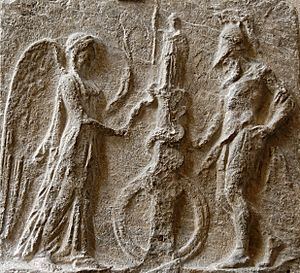Palladium (classical antiquity) facts for kids

In Greek and Roman mythology, the Palladium was a very old and special statue. People believed that the safety of the city of Troy depended on it. Later, the city of Rome also believed its safety depended on a Palladium.
The original Trojan Palladium was a wooden statue of Pallas Athena. Two Greek heroes, Odysseus and Diomedes, stole it from the citadel (fortress) of Troy. Later, a Trojan hero named Aeneas supposedly took it to the future site of Rome. The Roman story is told in Virgil's famous poem, the Aeneid.
For many centuries, Rome had an object they believed was the real Palladium. It was kept safe by the Vestal Virgins, who were priestesses. Today, the word "palladium" can mean anything that is believed to offer protection or safety. This idea became popular in the Eastern Christian church after Emperor Justinian I's rule. Later, it spread to the Western church too. Sometimes, these protective objects were carried around city walls during a siege or even taken into battle.
Contents
The Trojan Palladium
How it Started
The Trojan Palladium was said to be a wooden statue of Pallas. The Greeks connected Pallas with their goddess Athena. The Romans connected her with their goddess Minerva. People believed the statue fell from the sky. It was said to be a gift from the gods after Ilus, the founder of Troy, prayed for help.
Coming to Troy
The story of the Palladium arriving in Troy is part of the city's founding myth. Some stories say Athena made the Palladium because she felt bad about Pallas's death. Other tales say it was given to Dardanus, who was an ancestor of the Trojan kings. One story says King Ilus was blinded for touching the statue. He did this to save it from a burning temple.
The Famous Theft
During the Trojan War, the Greeks learned how important the Palladium was to Troy. Helenus, a son of Priam and a prophet, told them. He said Troy would not fall as long as the Palladium was inside its walls.
So, the dangerous job of stealing this sacred statue fell to Odysseus and Diomedes. These two heroes snuck into Troy's citadel through a secret passage. They took the statue, leaving the city open to the trick of the Trojan Horse.
According to one story, Odysseus went into Troy disguised as a beggar. Helen recognized him and told him where the Palladium was. After some sneaky actions, he returned to the ships. Then, he and Diomedes went back into the city and stole the statue. Diomedes is often shown carrying the Palladium to the ships in ancient art.
Another story says that on their way back, Odysseus tried to kill Diomedes. He wanted to take all the credit for stealing the Palladium. But Diomedes saw the flash of Odysseus's sword in the moonlight. He quickly took Odysseus's sword, tied his hands, and made him walk in front. Diomedes hit Odysseus's back with the flat side of his sword. This led to a Greek saying, "Diomedes' necessity," meaning someone acting under force. Diomedes did not seriously hurt Odysseus because Odysseus was needed to help destroy Troy. Diomedes took the Palladium with him when he left Troy. Some stories say he brought it to Italy. Others say it was stolen from him on the way.
Its Journey to Rome
Different versions of the legend say the Trojan Palladium ended up in Athens, Argos, Sparta (all in Greece), or Rome in Italy. If it went to Rome, it was either brought by Aeneas, the Trojan hero, or given to Rome by Diomedes himself. In this version, Diomedes only stole a copy of the statue.
An actual object believed to be the Palladium was kept in the Temple of Vesta in the Roman Forum for many centuries. It was seen as one of the pignora imperii. These were sacred items that guaranteed Rome's power and rule.
Pliny the Elder, a Roman writer, said that Lucius Caecilius Metellus was blinded by fire. This happened when he saved the Palladium from the Temple of Vesta in 241 BC. Later, the emperor Elagabalus (who ruled from 218–222 AD) moved many sacred Roman items to his own temple. The Palladium was among them.
In later times, people rumored that the Palladium was moved from Rome to Constantinople. This was done by Constantine the Great. It was supposedly buried under the Column of Constantine in his forum. This move would have made Constantinople seem more important than Rome. It was seen as a way for Constantine to make his rule and new capital city more legitimate.
The Athenian Palladium
The goddess Athena was also worshipped on the Acropolis of Athens under many names. One of her most important roles was Athena Poliás, meaning "protectress of the city." The statue for the Poliás cult was a wooden figure. It was often called the "xóanon diipetés" (the "carving that fell from heaven"). This statue was made of olive wood. In the classical era, it was kept in the east wing of the Erechtheum temple.
People believed this statue was not made by humans but came from the gods. It was the holiest image of the goddess and was highly respected. It was placed under a bronze palm tree, and a gold lamp burned in front of it.
A big part of the Panathenaea festival was replacing this statue's woolen peplos (a type of garment) with a new one. The priestesses also carried it to the sea once a year. They would ceremonially wash it in a festival called the Plynteria ("washings"). The last mention of its presence was by the Christian writer Tertullian. He described it as just "a rough stake, a shapeless piece of wood." Older descriptions of the statue have not survived.
See also
- Tutelary deity

